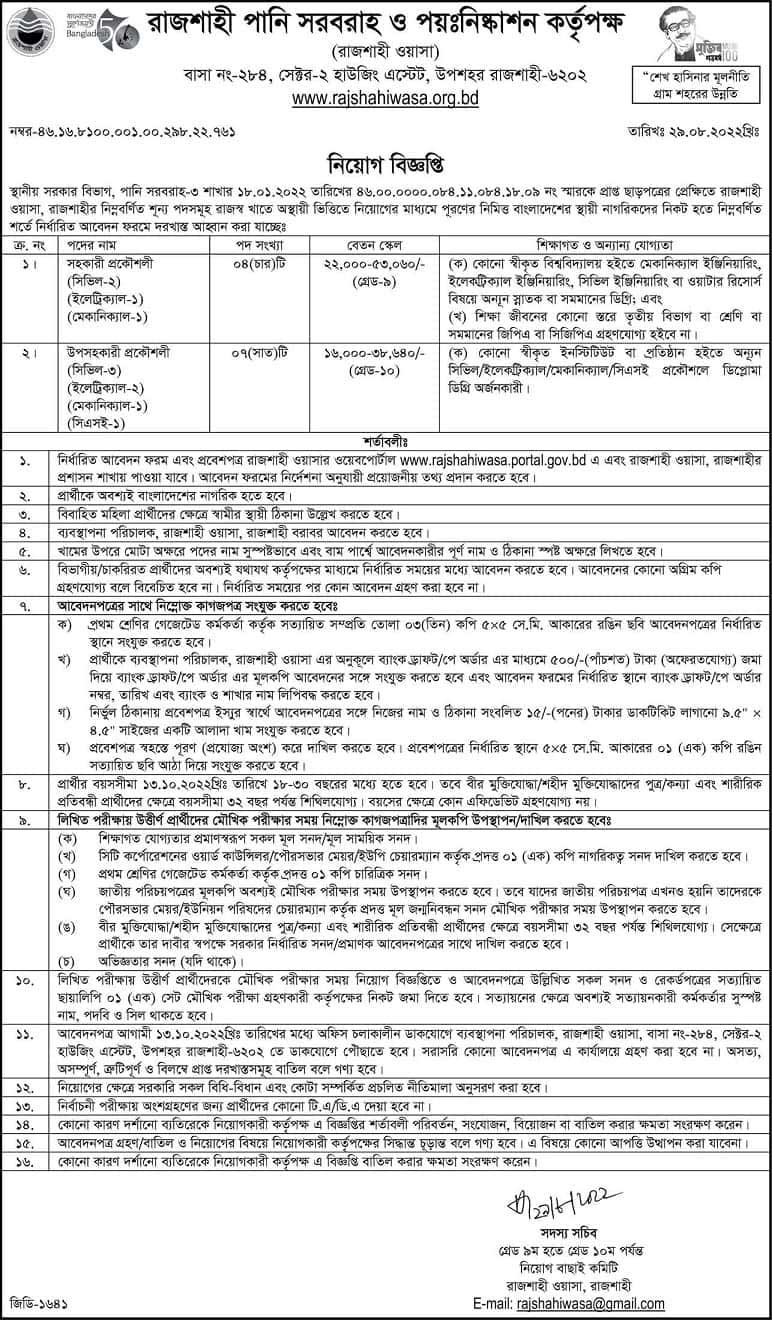Wasa job circular 2022 publish. Dhaka Water Supply and Sewerage Authority is a Bangladeshi government agency under the Ministry of Local Government, Rural Development and Cooperatives responsible for water and sewerage in the capital of Bangladesh, Dhaka and Narayanganj. On 16 March 2019, the Parliamentary Standing Committee on Estimates recommended to the Bangladesh government to split Dhaka WASA into two separate bodies, North and South Dhaka as well. In a 2019 report, Transparency International Bangladesh stated that Dhaka WASA engaged in “rampant graft” and provided “poor service”. Four out of WASA’s ten zones are supplying water contaminated with harmful bacteria. According to the WASA report submitted to the Bangladesh High Court, Dhaka WASA is supplying contaminated water to 57 areas of Dhaka. Check Wasa job circular 2022.
It is one of the largest cities in Bangladesh and one of the 11 municipal corporations in the country. Rajshahi Municipality was establish in 1876. It is one of the first municipalities in intact India. In 1987, Rajshahi Municipality was convert into a City Corporation with an area of 48.47 sq km. chakrirkbr.com Currently, the municipal area has increased to 93.47 sq km. Although industrial institutions are not establish here, many higher educational institutions are establish. Extensive sericulture is observed in Rajshahi region and Bangladesh’s only sericulture laboratory is also located in Rajshahi city hence Rajshahi city is called the city of sericulture and education. The present population of Rajshahi City Corporation is about 9 lakh including slums and floating population. Check WASA job Circular 2022.
Wasa job circular 2022
- Number of posts: 11
- Age limit: 18 to 30
- Application Deadline: 13 October 2022
- See application form below

New job circular
- Saptahik Chakrir khobor Potrika 16 February 2024
- SFDF Job Circular 2024 Vacancy 150 New
- Prothom Alo Chakri Bakri Potrika 22 September 2023
- Saptahik Chakrir Dak Potrika 22 September 2023
- Saptahik Chakrir Songbad Potrika 22 September 2023
[ads3]
Bangladesh WASA job Circular 2022
In 1937, water supply system was started in the first Rajshahi city under the Rajshahi municipality under the initiative of the water supply branch of the then Ministry of Works of Calcutta, India. In order to ensure uninterrupted water supply in this supply system, 100 vertical reservoirs with a capacity of 470 gallons were installed along the road in 1937 with the help of a donation of 2.5 lakh rupees by Rani Hemanta Kumari of Puthiya, locally known as “Dhop Kal”. Even today, in many parts of the city, these Dhop mills are standing with the tradition of water supply and meeting the water needs of the city dwellers.
The water treatment plant located at Hetam Khan had a capacity of 700 cubic meters per day. jobpaperbd.com This water treatment plant was declare abandon in 1965. At present 70% of the population meets their water needs through pipe lines and 30% through manual tube wells. Rajshahi City Corporation constructed elevated reservoirs to bring discipline in water management. Note that due to the limitations of the Dutch aided scheme it was not sufficient to meet the water needs of the urban population.
